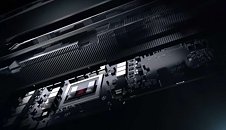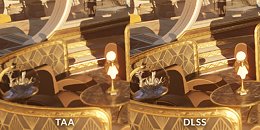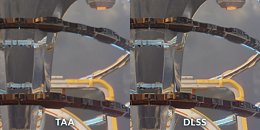Thursday, February 14th 2019

AMD Doesn't Believe in NVIDIA's DLSS, Stands for Open SMAA and TAA Solutions
A report via PCGamesN places AMD's stance on NVIDIA's DLSS as a rather decided one: the company stands for further development of SMAA (Enhanced Subpixel Morphological Antialiasing) and TAA (Temporal Antialising) solutions on current, open frameworks, which, according to AMD's director of marketing, Sasa Marinkovic, "(...) are going to be widely implemented in today's games, and that run exceptionally well on Radeon VII", instead of investing in yet another proprietary solution. While AMD pointed out that DLSS' market penetration was a low one, that's not the main issue of contention. In fact, AMD decides to go head-on against NVIDIA's own technical presentations, comparing DLSS' image quality and performance benefits against a native-resolution, TAA-enhanced image - they say that SMAA and TAA can work equally as well without "the image artefacts caused by the upscaling and harsh sharpening of DLSS."
Of course, AMD may only be speaking from the point of view of a competitor that has no competing solution. However, company representatives said that they could, in theory, develop something along the lines of DLSS via a GPGPU framework - a task for which AMD's architectures are usually extremely well-suited. But AMD seems to take the eyes of its DLSS-defusing moves, however, as AMD's Nish Neelalojanan, a Gaming division exec, talks about potential DLSS-like implementations across "Some of the other broader available frameworks, like WindowsML and DirectML", and that these are "something we [AMD] are actively looking at optimizing… At some of the previous shows we've shown some of the upscaling, some of the filters available with WindowsML, running really well with some of our Radeon cards." So whether it's an actual image-quality philosophy, or just a competing technology's TTM (time to market) one, only AMD knows.
Source:
PCGamesN
Of course, AMD may only be speaking from the point of view of a competitor that has no competing solution. However, company representatives said that they could, in theory, develop something along the lines of DLSS via a GPGPU framework - a task for which AMD's architectures are usually extremely well-suited. But AMD seems to take the eyes of its DLSS-defusing moves, however, as AMD's Nish Neelalojanan, a Gaming division exec, talks about potential DLSS-like implementations across "Some of the other broader available frameworks, like WindowsML and DirectML", and that these are "something we [AMD] are actively looking at optimizing… At some of the previous shows we've shown some of the upscaling, some of the filters available with WindowsML, running really well with some of our Radeon cards." So whether it's an actual image-quality philosophy, or just a competing technology's TTM (time to market) one, only AMD knows.



170 Comments on AMD Doesn't Believe in NVIDIA's DLSS, Stands for Open SMAA and TAA Solutions
Thing is, AMD has zero innovation (besides "more Vram guys, let's add some more Vram") What a terrible competition AMD is. Come on Intel, show AMD how competing with Nvidia is done.
To summarize. Nvidia didn't invent anything new with DLSS as you perceive it. Blurriness for me have been with us a long time. Calling something DLSS and telling people this is a new technology isn't ok. Maybe it brings something new to the table but, I hope, this is yet to be seen. NV's focus, as we all know, is on money so this DLSS is more of a marketing than actual innovation for me (innovation with poor image quality). Especially when they come up with some new tech ditching all other 1-2 years old innovation bringing something new to the table to charge more for it.
I stick with AMD and open techniques for improving image quality and implement new stuff. This is just another way for NV (that's just my opinion) to give "something new that only they have" (but in fact it's been in the market already developed) to charge more and convince customers and game developers that's they way to go and of course charge more.
Just like it is with G-Sync and just like it will be with G-sync compatible ( which in fact is free sync). that's just lame. :)
AMD is forced to market itself with open tech, it's actually a smart business move. Who knows how open AMD would be if it were in the nr.1 position. AMD is just picking up the crumbs that Nvidia left under the table. Which is sad, I really want AMD to be equal to Nvidia
I'm referring to the SMAA and TAA since that what this thread is about.Really? So innovation in your dictionary is something new but not necessarily made for improving something but make it worse?
What crumbs? NV feed you with your "innovations" which give nothing but drops down on an image quality. We look for improvements not deterioration and still calling it innovation.
Also, RT is the next step towards realism, I really like what I'm seeing. Innovation in the VGA sector has been pretty bland in the last couple of years, and behold the only meaningful innovation (RT) is delivered by Nvidia. Where is AMD? I want AMD to innovate and make Nvidia crawl back in shame. But it's not happening.
gpuopen.com/games-cgi/#effects
Of course, they are optimized for GCN, but that is expected.
I am not saying it does not increase input latency but is there a reason to think it does?
Edit: with a bit of searching, TressFX is also in Rise of the Tomb Raider (version modified by Square Enix), Deus Ex: Mankind Divided (TressFX 3.0).
These are not branded and marketed like Nvidia's GameWorks. Being open, pretty much anyone is free to modify and include them in their software. Bigger engines probably have most of this stuff included.
If they are comparing multiple frames and combining them to construct the image you see, then you will always behind as many frames as they compared.